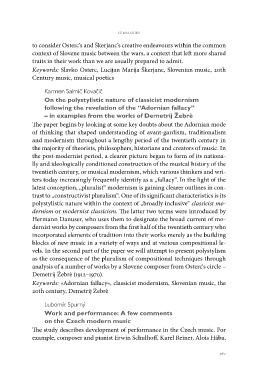Page 369 - Weiss, Jernej, ur. 2018. Nova glasba v “novi” Evropi med obema svetovnima vojnama ?? New Music in the “New” Europe Between the Two World Wars. Koper/Ljubljana: Založba Univerze na Primorskem in Festival Ljubljana. Studia musicologica Labacensia, 2
P. 369
summaries
to consider Osterc’s and Škerjanc’s creative endeavours within the common
context of Slovene music between the wars, a context that left more shared
traits in their work than we are usually prepared to admit.
Keywords: Slavko Osterc, Lucijan Marija Škerjanc, Slovenian music, 20th
Century music, musical poetics
Karmen Salmič Kovačič
On the polystylistic nature of classicist modernism
following the revelation of the “Adornian fallacy”
– in examples from the works of Demetrij Žebrè
The paper begins by looking at some key doubts about the Adornian mode
of thinking that shaped understanding of avant-gardism, traditionalism
and modernism throughout a lengthy period of the twentieth century in
the majority of theorists, philosophers, historians and creators of music. In
the post-modernist period, a clearer picture began to form of its nationa-
lly and ideologically conditioned construction of the musical history of the
twentieth century, or musical modernism, which various thinkers and wri-
ters today increasingly frequently identify as a „fallacy“. In the light of the
latest conception, „pluralist“ modernism is gaining clearer outlines in con-
trast to „constructivist pluralism“. One of its significant characteristics is its
polystylistic nature within the context of „broadly inclusive“ classicist mo-
dernism or modernist classicism. The latter two terms were introduced by
Hermann Danuser, who uses them to designate the broad current of mo-
dernist works by composers from the first half of the twentieth century who
incorporated elements of tradition into their works merely as the building
blocks of new music in a variety of ways and at various compositional le-
vels. In the second part of the paper we will attempt to present polystylism
as the consequence of the pluralism of compositional techniques through
analysis of a number of works by a Slovene composer from Osterc‘s circle –
Demetrij Žebrè (1912–1970).
Keywords: »Adornian fallacy«, classicist modernism, Slovenian music, the
20th century, Demetrij Žebrè
Lubomír Spurný
Work and performance: A few comments
on the Czech modern music
The study describes development of performance in the Czech music. For
example, composer and pianist Erwin Schulhoff, Karel Reiner, Alois Hába,
367
to consider Osterc’s and Škerjanc’s creative endeavours within the common
context of Slovene music between the wars, a context that left more shared
traits in their work than we are usually prepared to admit.
Keywords: Slavko Osterc, Lucijan Marija Škerjanc, Slovenian music, 20th
Century music, musical poetics
Karmen Salmič Kovačič
On the polystylistic nature of classicist modernism
following the revelation of the “Adornian fallacy”
– in examples from the works of Demetrij Žebrè
The paper begins by looking at some key doubts about the Adornian mode
of thinking that shaped understanding of avant-gardism, traditionalism
and modernism throughout a lengthy period of the twentieth century in
the majority of theorists, philosophers, historians and creators of music. In
the post-modernist period, a clearer picture began to form of its nationa-
lly and ideologically conditioned construction of the musical history of the
twentieth century, or musical modernism, which various thinkers and wri-
ters today increasingly frequently identify as a „fallacy“. In the light of the
latest conception, „pluralist“ modernism is gaining clearer outlines in con-
trast to „constructivist pluralism“. One of its significant characteristics is its
polystylistic nature within the context of „broadly inclusive“ classicist mo-
dernism or modernist classicism. The latter two terms were introduced by
Hermann Danuser, who uses them to designate the broad current of mo-
dernist works by composers from the first half of the twentieth century who
incorporated elements of tradition into their works merely as the building
blocks of new music in a variety of ways and at various compositional le-
vels. In the second part of the paper we will attempt to present polystylism
as the consequence of the pluralism of compositional techniques through
analysis of a number of works by a Slovene composer from Osterc‘s circle –
Demetrij Žebrè (1912–1970).
Keywords: »Adornian fallacy«, classicist modernism, Slovenian music, the
20th century, Demetrij Žebrè
Lubomír Spurný
Work and performance: A few comments
on the Czech modern music
The study describes development of performance in the Czech music. For
example, composer and pianist Erwin Schulhoff, Karel Reiner, Alois Hába,
367


